
Cones on a tree of J. flaccida near Zaragoza, Nuevo Leon [Jeff Bisbee, 2014.09].
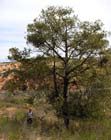
Tree, collected along the toll road ca. 130 km N of Oaxaca [R. Van Pelt, 2005.02.08].
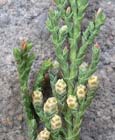
Scale foliage and pollen cones from the tree shown above [C.J. Earle, 2005.02.08].

Branchlet from the tree shown above [C.J. Earle, 2005.02.08].
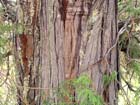
Bark of the tree shown above, about 50 cm dbh [C.J. Earle, 2005.02.08].
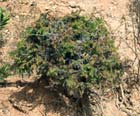
Sapling growing near the tree shown above. It is about 60 cm tall, has been heavily browsed, and retains acicular foliage [R. Van Pelt, 2005.02.08].
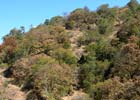
Woodland of deciduous oak (Quercus sp.) and J. poblana along the toll road about 50 km N of Oaxaca [R. Van Pelt, 2005.02.11].

A tree about 8 m tall in Morelos [C.J. Earle, 2007.02.16].
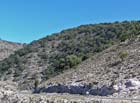
Growing on a N-facing slope in Morelos [C.J. Earle, 2007.02.16].

Conservation Status

Juniperus flaccida
Schlechtendal 1838
Common names
Drooping juniper, drooping cedar (Peattie 1950), cedro, cedro liso, cipres, enebro, sabino, tlascal, tascate, Mexican drooping juniper (Zanoni and Adams 1979), weeping juniper (Adams 2004).
Taxonomic notes
For a long time (from the mid-19th Century to about 2006), there was only one Mexican juniper with drooping foliage, and it was called Juniperus flaccida. In 1946 Martínez segregated a variety from near the southern distribution of the species with its foliage borne in planar splays, and in 1985 Perez de la Rosa identified a similar species with smaller cones and fewer seeds, which was quickly reduced to status as another variety of J. flaccida. In 2006, RAPD sequencing for these three varieties revealed it to be polyphyletic, and each variety was then elevated to species rank (Adams et al. 2006). Thus J. flaccida sensu strictu is now regarded as the flaccid-leaved Mexican juniper that has relatively large cones (9-20 mm diameter) and foliage that is not held in planar sprays. As such, there are no described infraspecific taxa.
Synonymy (Adams 2004):
- Juniperus gracilis Endl., Syn. Conif.: 31 (1847).
- J. gigantea Roezl in part
- J. flaccida var. gigantea (Roezl) Gaussen
- J. foetida flaccida (Schlecht.) Spach
- Sabina flaccida (Schlecht.) Antoine, Cupress.-Gatt.: 37 (1857).
- S. flaccida (Schlecht.) A. A. Heller
- S. flaccida (Schlecht.) I.M. Lewis
Description
Dioecious trees up to 12 m tall, trunks forking 1-2 m above base, crown globose. Bark cinnamon red-brown or gray red-brown, exfoliating in broad interlaced fibrous strips. Bark on branchlets (5-10 mm diameter) smooth, that on larger branches exfoliating in wide strips or plates. Branches drooping; branchlets drooping, flaccid; branching radial around older branches, forming space-filling (not planar) sprays. Leaves green, abaxial gland variable, elongate, conspicuous, exudate absent, decurrent leaves 4-6 mm, not glaucous adaxially; scale leaves (which often resemble the decurrent leaves) on ultimate twigs 1.5-2 mm, opposite, narrowly ovate, acuminate. Seed cones maturing in 1 year, of similar size, with straight to curved peduncles, globose, 9-20 mm, tan-brown to brown-purple when mature, glaucous, obscurely woody, smooth or with horn-like protuberances from the enlarged cone-scale tips, with (4-)6-10(-13) seeds. Seeds 5-6 mm long. Pollen is shed late winter-early spring (Adams 2004 [describing, at that time, var. flaccida]).
The species closely resembles J. martinezii and both varieties of J. poblana. Adams and Schwarzbach (2015) present the following key to separate the species in this group:
1. |
Seed cones large, 9-17 mm diam., (4-) 6-10 (-13) seeds per cone, terminal branch tips drooping (hanging) |
|
2 |
2. |
Seed cones 9 - 20 mm diam., with (4-) 6-10 (-13) seeds, foliage weeping |
|
J. poblana var. poblana |
2. |
Foliage weeping, branching radially, seed cones brownish-purple, tan-brown |
|
3 |
3. |
All leaves decurrent, with free tips, foliage very weeping, bark exfoliating in thin, scaly, plates |
|
J. poblana var. decurrens |
3. |
Leaves decurrent with mostly appressed tips, foliage weeping, bark exfoliating in thick, interlaced stripes |
|
J. flaccida |
1. |
Seed cones small, (5-)6(-9) mm diam., 1-2(-3) seeds per cone, terminal branch tips erect |
|
J. martinezii |
Distribution and Ecology
Mexico: Chihuahua, Coahuila, Distrito Federal, Durango, Guanajuato, Guerrero, Hidalgo, Jalisco, México, Michoacán, Morelos, Nuevo León, Oaxaca, Puebla, Queretaro, San Luis Potosí, Sonora, Tamaulipas, and Zacatecas; and USA: Texas (Zanoni and Adams 1979), where it grows in the Chisos Mtns. at 1830 to 2440 m (Peattie 1950). See also Thompson et al. 1999. Hardy to Zone 8 (cold hardiness limit between -12.1°C and -6.7°C) (Bannister and Neuner 2001).
Distribution data from USGS (1999). Note that this map includes all three taxa known as J. flaccida prior to 1986; however J. flaccida s.s. is considerably more widely distributed than either J. poblana or J. martinezii.
The estimated extent of occurrence is well in excess of 20,000 km2, so the conservation status is "least concern;" while this species is subject to fire and overgrazing in some areas, no overall decline is evident (Farjon 2013).
Remarkable Specimens
American Forests (1996) gives the largest as a tree with diameter 82 cm, height 17 m, and crown spread 11 m, located in Big Bend National Park, Texas. It is possible that larger specimens occur in Mexico, but I have no information on this.
Ethnobotany
Observations
Remarks
Citations
Adams, Robert P. 2004. Junipers of the World: The Genus Juniperus. Trafford Publishing.
Brief versions of the descriptions are available online at www.juniperus.org.
Adams, R.P., J.A. Perez de la Rosa and M. Charzaro. 1990. The leaf oil of Juniperus martinezii Perez de la Rosa and taxonomic status. J. Essential Oil Res. 2:99-104. Available online at juniperus.org.
Adams, R. P., A. E. Schwarzbach and S. Nguyen. 2006. Re-examination of the taxonomy of Juniperus flaccida var. martinezii, and var. poblana (Cupressaceae) Phytologia 88(3):233-241.
Adams, R. P., and A. E. Schwarzbach. 2015. A new, flaccid, decurrent leaf variety of Juniperus poblana from Mexico: J. poblana var. decurrens R. P. Adams & S. González. Phytologia 97(3):152-163.
American Forests 1996. The 1996-1997 National Register of Big Trees. Washington, DC: American Forests.
Farjon, Aljos. 2013. Juniperus flaccida var. poblana. The IUCN Red List of Threatened Species, Version 2015.2. www.iucnredlist.org, accessed 2015.07.28.
See also
Adams, R. P., and T. A. Zanoni. 2015. The volatile leaf oils of Juniperus flaccida Schltdl., J. martinezii Perez de la Rosa and J. poblana (Mart.) R. P. Adams, re-examined. Phytologia 97(2): 145-151.
Elwes and Henry 1906-1913 at the Biodiversity Heritage Library. This series of volumes, privately printed, provides some of the most engaging descriptions of conifers ever published. Although they only treat species cultivated in the U.K. and Ireland, and the taxonomy is a bit dated, still these accounts are thorough, treating such topics as species description, range, varieties, exceptionally old or tall specimens, remarkable trees, and cultivation. Despite being over a century old, they are generally accurate, and are illustrated with some remarkable photographs and lithographs.
Farjon (2005) provides a detailed account, with illustrations.
Threatened Conifers of the World.









